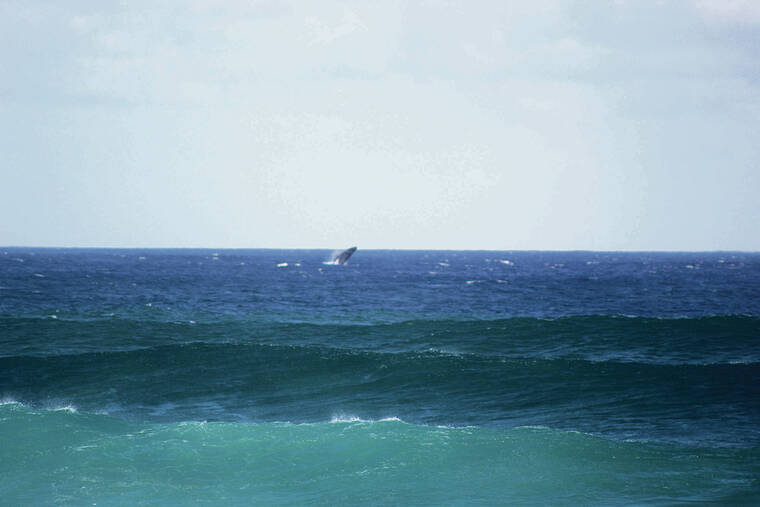A one-day humpback whale count was conducted by volunteers Saturday on the shores of the main Hawaiian Islands, with 136 whales sighted between 10 and 10:15 a.m., the most of any 15-minute period throughout the day, according to a news release from the Hawaiian Islands Humpback Whale National Marine Sanctuary and the Pacific Whale Foundation.
A total of 241 volunteers participated in the four-island event, which combined the sanctuary’s Ocean Count on Oahu, Kauai and Hawaii island and the foundation’s Great Whale Count on Maui.
It was the fourth year that both organizations’ whale counts were held on the last Saturdays in January, February and March.
While this season’s totals for the three days were higher than last year’s and almost equivalent to 2019, this doesn’t in itself indicate the population is reviving after a sharp decline in 2015, said Cindy Among-Serrao, Hawaii island coordinator for the sanctuary, in an email.
The one-day volunteer counts provide a snapshot of humpback whale sightings and activity from the shoreline across multiple sites, as distinguished from deeper research into population trends, she explained.
“As for the population trends, it has been highly variable lately, and the last definitive population data collection that was done was back in 2004-2006,” Among-Serrao said.
“With the high variability that we have seen with feeding patterns and migration patterns,” she added, population trends “will need to be explored/discussed more.”
The humpback whale sanctuary and Pacific Whale Foundation ran modified programs this year and last due to COVID-19 pandemic safety precautions, Among- Serrao noted, and in 2020 the March count was canceled altogether.
Entanglements of whales in fishing gear do provide some indication of population trends, and this year has been busy, according to Ed Lyman, the sanctuary’s natural resource specialist and acting regional large-whale entanglement response coordinator.
“If there are more whales, we’re likely to have more entanglement,” Lyman said in a phone interview Monday. “We have had a busy season, (with) more reports of confirmed whale entanglements than in the last couple years, but not that many more.”
This season his team responded to five reports of large whales entangled in gear, “and we’ve successfully gotten the gear off, sometimes in significant amounts,” he said, noting the team’s average is two successful disentanglements per season.
Technically, he added, six whales were rescued because one case involved a mother with a young calf, and “by freeing the mother, we helped the calf as well,” since “if the mother had died, the calf would have died.”
In addition, there were 10 ship strikes, or contacts, reported and confirmed, he said, which “is definitely higher than the last couple of years.”
However, Lyman added, that doesn’t necessarily mean there have been more whale-vessel collisions, only more that were reported.
“Another variable is the effort: Who is out there to find them?” he said. “COVID might have reduced or changed the effort; tour boats help us a lot by reporting contacts, but they probably weren’t out as much.”
Lyman added that he responded to a call Sunday reporting an injured whale calf and determined it had been struck by a boat.
The mother was with her wounded calf, “and she appeared very protective,” he said.
On Monday, Lyman came across the mother alone.
“It is unbelievably sad to see,” he said. “Unlike the entanglements, there’s really not much we can do” about strike wounds.
For more information, visit hawaiihumpbackwhale.noaa.gov Opens in a new tab.

